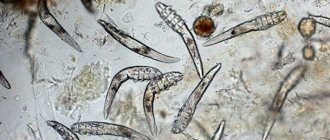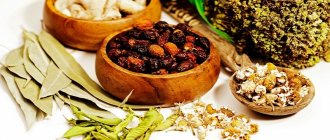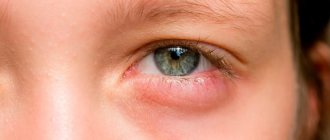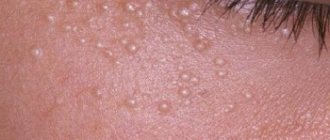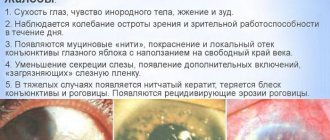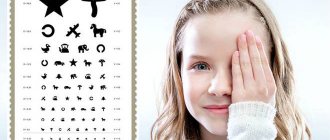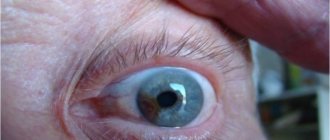Glaucoma is a serious eye disease that is accompanied by increased intraocular pressure and decreased vision. Glaucoma can be primary or develop against the background of another disease.
Attention! These methods are provided for informational purposes only and can only be used as an addition to treatment prescribed by a doctor under his supervision. Do not self-medicate!!!
A small amount of aqueous humor is constantly present in the cavity of the human eyeball. It is produced by some structures of the eye, and absorption occurs in other structures. This liquid is necessary to deliver nutrients to the organs of the eye and moisturize it from the inside. With glaucoma, the level of intraocular pressure increases as the amount of aqueous humor increases. The cause of this condition can be either excess production of intraocular fluid or a violation of its outflow. As a result, the eye tissues experience compression pressure, which causes damage. Visual function steadily declines, which can lead to complete blindness.
Very often, glaucoma begins unnoticed, and only subsequently the symptoms gradually intensify. However, there are cases when the first manifestation of glaucoma is an attack of acute intraocular hypertension. It is accompanied by sudden severe pain in the eye and head and a sharp decrease in visual function. To identify glaucoma, you need to know all the intricacies of the disease, since its symptoms are quite nonspecific and occur in other pathological conditions. Most often, the correct diagnosis is made by an ophthalmologist after measuring the level of intraocular pressure.
There are various methods you can use to reduce intraocular pressure at home.
A symptom of the initial stages of glaucoma is temporary blurred vision. Subsequently, a narrowing of the visual fields and a decrease in its acuity occur.
An acute attack of intraocular hypertension can occur at any stage of the disease. In this case, severe pain develops in the eye, which can spread to the ears, head, and teeth. Nausea and bouts of vomiting are often associated. The level of intraocular pressure during an acute attack of glaucoma reaches high levels and decreases gradually (symptoms persist for several days). However, each attack leads to damage to the nerve fibers, resulting in complete atrophy of the optic nerve sooner or later.
If you find any signs of glaucoma, you should contact an ophthalmologist as soon as possible, who, after examination, will be able to prescribe adequate treatment. It is important to get enough rest and sleep on a high pillow. It is also necessary to avoid eye strain.
To prevent glaucoma, traditional medicine recipes recommend consuming as many vegetables, fruits, and dairy (including fermented milk) products as possible. It is forbidden to stay in darkened rooms for a long time and wear dark glasses. Stress and strong emotions make a significant negative contribution to the development of glaucoma. Also, you should not perform actions related to tilting your head vertically. Coffee, alcoholic drinks, tea, smoked, salty and spicy foods should be excluded from the diet.
Bee Honey
Bee honey is used to treat glaucoma. To do this, dilute it with boiled water and use the solution as eye drops or lotions. This relieves signs of inflammation (conjunctivitis, lacrimation), and reduces the manifestations of glaucoma and cataracts.
In the early stages of glaucoma, beebread and pollen have a positive effect. Twice a year, you need to repeat monthly courses of treatment, during which you take 10 g of the product once in the morning before meals.
If you heat pure honey in a water bath and drop the resulting product into your eyes, you can not only reduce the inflammatory reaction, but also cleanse your eyes of mucus. You can also mix one tablespoon of apple cider vinegar, honey and 250 ml of water. Take the resulting solution once a day in the morning (a quarter of an hour before breakfast).
Another means of preventing glaucoma is a solution of honey in water (ratio 1 to 1). They rub it on the eyelids before going to bed.
Drops, rinsing
Treatment of glaucoma with traditional methods can be carried out using home-made drops. You need to take one egg, hard boil it, cut it in half and remove the yolk from it. Pour honey into the egg white cavity, combine both halves of the egg and leave it for a whole day. The resulting liquid must then be poured into a clean container and used as drops.
Drops made from honey and chicken protein improve vision
Before the procedure, it is recommended to splash cool water on your eyes for forty seconds. Then drop two drops of a preheated pipette into both eyes. This is done in the morning and evening. Such manipulations will help when the question arises of how to treat incipient glaucoma. These procedures lead to the restoration of intraocular pressure, and the lens itself becomes more transparent. The drops are stored in the refrigerator, the entire course is 30 days.
- How to treat cataracts with folk remedies
To cure glaucoma, it is not necessary to resort to radical methods. You can use simple methods. One of them is golden whisker drops. One leaf of this plant is thoroughly washed and the juice is squeezed out of it. The resulting composition should be dripped into the eyes once a day for ten days.
To treat this disease, you can use honey mixed with aloe juice. The components are taken in equal proportions, and a spoonful of vodka is added to them. The mixture is infused, after which it is used for instillation every day before going to bed. Treatment continues until improvement occurs.
Eyebright can be used as home therapy. You need to take 40 g of this plant, pour it with a small amount of water, strain the liquid and use it for instillation. You need to drop two drops into each eye once a day. Aloe can be used for therapeutic rinsing. The plant is finely chopped and then poured with a glass of boiling water. The liquid is infused for three hours, and the eyes are washed with the prepared solution three times a day.
Treatment of glaucoma at home should be comprehensive. Only then will it be possible to get a positive result. It is imperative to make lotions using medicinal herbs, not forgetting about drops and applications.
May herbs
The herbs are collected in May and dried in the sun.
- Half a glass of nettle, 2 tablespoons of strawberries and a spoonful of lily of the valley flowers are poured with half a liter of water and left for about eight hours. A teaspoon of soda is added to the resulting solution and used as a lotion.
- The herbs of wild rosemary, cudweed and motherwort are mixed (ratio 1 to 2 to 3) and an infusion is made. Take half a glass (half a teaspoon of dry mixture) three times a day. The medicine is used in courses, the duration of which depends on the therapeutic effect.
- Birch, horsetail, knotweed, tansy, plantain, coltsfoot are mixed in equal quantities and an infusion is made. Take a third of a glass twice a day for two weeks.
- Motherwort, cumin, fennel and valerian are mixed and an infusion is prepared. Take the solution half a glass three times a day for a month.
- Drink 50 ml of corn silk infusion three times a day after meals. This remedy is effective against glaucoma and vitreous pathology.
- Birch buds, parsley herb, elecampane root, blue cornflower and three-leaf watch are suitable for preparing a decoction. You need to drink it three times a day for two weeks.
- Ginger, licorice root, buckwheat, motherwort, cinnamon and lemon balm are mixed. After this, an infusion is made from a tablespoon of the mixture, which is taken half a glass three times a day. The medicine is used for the treatment and prevention of intraocular hypertension.
- Nettle leaves (3 large spoons), lily of the valley (one small spoon), soda (half a small spoon) are mixed with half a liter of boiling water. Make eye lotions from the resulting mass (for 5-7 minutes).
- Small duckweed (a tablespoon) is infused with vodka (250 ml) for four days. Take 15-20 drops 2-3 times a day, dissolving the tincture in water (a small amount).
- Blueberry leaves are crushed and poured with a liter of boiling water (8 teaspoons of raw materials). Take a glass of infusion three times a day before meals.
Treatment of acute glaucoma
In case of an acute attack of glaucoma and a severe form of the disease, the use of folk remedies is unacceptable. Unconventional methods can only be an additional measure to the main treatment prescribed by a specialist.
During an attack of acute glaucoma, the following drugs are prescribed:
- miotics, or drugs for constriction of the pupil, lowering IOP and spasm of accommodation (Pilocarpine up to 3-6 times a day, for diagnosis every 10-15 minutes);
- beta-blocker Timolol 0.5% or 0.25% to reduce IOP, normalize the outflow of intraocular humor and reduce its formation in the morning and evening;
- Diacarb to reduce blood pressure and reduce swelling - 0.25 mg tablet three times a day;
- if other drugs are ineffective - Lasix or Furosemide once a day, preferably in combination with Asparkam or Panangin tablets to replace calcium;
- it is possible to replace or supplement drugs with Dorzolamide (Dorzopt), Brinzolamide (Azopt) and other eye drops, used 1-2 times a day depending on the medication;
- Fotil and Fotil forte are combination drugs containing Pilocarpine and Timolol.
All medications are used as prescribed by a doctor in recommended dosages and are sold in pharmacies with a prescription. Self-medication during an acute attack of glaucoma is unacceptable. It is the specialist who diagnoses the cause of the disease, accompanying factors (increased IOP or normal, increased production of intraocular fluid, impaired outflow) and selects groups of medications.
Treatment with special exercises
When fluid outflow is impaired and intraocular hypertension develops, special exercises provide certain benefits:
- Slowly move your gaze from bottom to top and top to bottom (repeat six times). The exercise is performed 3-4 times with short breaks (5 seconds each).
- Move your gaze just as slowly from right to left and in the opposite direction. You can't turn your head while doing this. Perform the exercise 2-3 times.
- Without turning your head, describe a circle with your eyes clockwise and then counterclockwise.
- Place a pencil, pen or index finger at a distance of 25 cm from the eyes. Fix your gaze on the tip of the object for a few seconds and move your gaze to a more distant object (3.5 meters). Next, turn your gaze back to the nearest object. Repeat the exercise 10 times, then rest with your eyes closed for 10 seconds. Perform 20-30 such cycles, increasing speed. In this case, both near and distant objects must be clearly visible. This technique is similar to an exercise called glass marking, which is used to treat myopia.
For all eye pathologies, including glaucoma, you need to increase the amount of foods enriched with vitamins C and A. You should focus on cabbage, tomatoes, carrots, citrus fruits, and berries. It is also advisable to protect your eyes from direct sunlight with dark glasses. You need to work in normal lighting, do not tilt your head forward, as this increases the production of aqueous humor, and do not read at dusk.
Proper nutrition for glaucoma
When identifying an ophthalmological disease, it is important not only to create a balanced diet, but also to take vitamin and mineral complexes. They strengthen the optic nerve and normalize metabolism.
Doctors recommend following a dairy-vegetable diet for glaucoma, which includes dishes and foods rich in microelements. Vitamins restore cells and tissues of the organ of vision. Beta-carotene slows down the processes of destruction of eye structures. For glaucoma, you need to consume more foods containing B vitamins 1,2,6 and 12. They activate cell growth, restore carbohydrate metabolism and control oxidative processes.
Introduce dairy products, lean meat, cereals, vegetables and fruits into your diet. Minimize the amount of easily digestible carbohydrates (sweets), eliminate sour cream and butter. It is forbidden to consume coffee, spices, and offal.
A unique set of exercises
For the prevention of glaucoma, a unique complex of eye gymnastics is excellent, on which you will spend no more than 10-15 minutes a day:
- Place your index fingers on your eyebrows, your thumbs on your temples, and make circular movements towards the middle of your eyebrows (repeat 50 times). After this, move your thumb to the right three centimeters and repeat the massage. Next, move 5 cm to the left and also perform 50 circular movements.
- Massage under the eye in the area of the edge of the orbit 50 times.
- Place your index finger in the area of the inner corner of the eye and gently make circular movements 50 times.
- Then move your finger to the outer corner of the eye and repeat the steps.
- Place your fingers below the tear duct and repeat the massaging movements 50 times.
- Place your thumbs in the area of the temporal recesses and massage this area well.
Glaucoma - causes and symptoms
Predisposing factors contributing to the development of the disease are farsightedness, myopia, hormonal disorders, atherosclerosis, diabetes mellitus, and age over 50 years. Today, a hereditary predisposition to the occurrence of the disease has been proven.
The disease is considered a silent thief of vision, it occurs unnoticed, proceeds without pronounced symptoms until a person detects the onset of a sharp deterioration in vision.
The early stage is asymptomatic; as the disease progresses, patients begin to experience severe headaches, rainbow halos appear around light sources, blurred vision, and a sensation of a foreign object. Over time, the visual field narrows and visual acuity decreases.
Sometimes an acute attack develops, which is facilitated by a sharp increase in intraocular pressure. Accompanied by a general deterioration of the condition and nausea. Immediate medical attention is required; an attack can lead to complete loss of vision.
For a long time, the signs of the disorder remain invisible, and the process of complete loss of vision stretches for many years. For timely detection of the disease, regular consultations with an ophthalmologist are important. Timely diagnosis and proper therapy will help quickly get rid of the disease.
This is a dangerous disease that requires immediate treatment. It is important to know that traditional medicine recommends a huge number of medicinal herbs for healing the disease, which can be combined with the prescriptions of the ophthalmologist.
Hirudotherapy
It was previously found that hirudotherapy improves lymphatic drainage by 10 times, so this technique is used in patients with glaucoma. In this case, additional pathways for the outflow of aqueous humor are created, due to which this area is cleared of metabolic products of eye cells.
For patients with glaucoma, leeches are placed on the temple, preauricular and postauricular lymph nodes, as well as on the back of the neck in the area of the initial cervical vertebrae. It is recommended to place no more than 5 leeches in one session. Courses of 5-7 days alternate with a week's rest.
The effectiveness of using folk remedies
Using folk remedies, the body is maintained with the necessary elements and minerals, but this does not guarantee the restoration of the visual organ in case of glaucoma. This disease is characterized by a collective concept of a group of diseases that provoke disruption of fluid circulation, most of which have never been clinically studied. Therefore, an important point in the use of traditional medicine is the approval of this method of additional treatment by a doctor.
The above methods will be effective only in the early stages of the disease, when intraocular pressure is relatively normal - from 22 to 26 mm Hg. according to Maklakov. Afterwards, only general strengthening recipes are used to maintain the whole body.
Drops and ointments prepared by hand are discussed with your doctor, because... some components may inhibit the active ingredients of medications.
How and with what to treat when using traditional methods?
Traditional recipes help stabilize the condition, but do not provide a guaranteed effect. The variety of home methods makes it difficult to select a remedy. It will take more than one month to try all the options for tinctures, teas and compresses. At the same time, when choosing a medicine, the doctor checks a list of 5-7 drugs.
During the initial examination, the choice is even easier: the specialist prescribes eye drops in accordance with the diagnosed disorders. There are several types of disorders that provoke glaucoma:
- Copious discharge of eye fluid. The pressure in the eye depends on the amount of fluid that lubricates and nourishes the external elements of the eyeball. If more moisture is released than necessary, an excess is formed. It provokes surges in blood pressure.
- Insufficient mobility of ocular fluid. The human eye needs constant nourishment, washing and cleansing. The moisture in the eye is in constant motion. It transfers nutrients, removes small debris and large contaminants that can scratch the cornea. If the fluid becomes viscous, it is released from the eye more slowly, although it is produced at the usual rate. When too much moisture accumulates, the eyes become red and begin to hurt.
- Complex disorders. A large group of disorders that includes all changes known to medicine that lead to glaucoma.
If the latter case requires special attention from the doctor, then the first two allow you to prescribe “first-choice drugs.” These medications regulate the defect after the first use. A small number of contraindications and a small list of side effects allow us to recommend them in most cases.
How to combine drugs with folk remedies
Use any tinctures, teas, gymnastic complexes, etc., unless you have contraindications for the chosen recipe. Home medicine does not have the same pronounced effect as pharmacological drugs. The active components in medicinal decoctions are presented in safe doses. Even if you accidentally exceed the dosage by 2-3 times, this will not affect your health.
To achieve the greatest effect, be consistent in using home remedies. Herbal teas and decoctions give noticeable results only with systematic use. The same goes for compresses. If one session provides immediate relief, then two weeks of sessions will stabilize the secretion of eye fluid for 1-2 months.
Set yourself up for a realistic result. Ignore prescriptions that promise complete healing, restoration of visual acuity, etc. Modern medicine does not know how to completely cure glaucoma; the likelihood that it is known to a stranger on the Internet is reduced to zero. Accordingly, it is not the disease that needs to be treated, but its symptoms. The same applies to tinctures based on expensive and supposedly rare components. Does the site recommending the legendary glaucoma herb have a checkout button? Pass by: they are trying to deceive you.
Types of glaucoma in older people
- Primary open angle. Progresses almost asymptomatically. The danger lies in irreversible, complete loss of vision.
- Primary closed-angle. It is two to three times less common than the open-angle form. Women are more likely to suffer from this type of glaucoma.
- Normal pressure glaucoma. It is characterized by negative changes in vision and damage to the optic nerve at a tolerable level of intraocular pressure.
- Pigmentary glaucoma. A rather rare form of vision pathology. It manifests itself by the leaching of pigment from the epithelium of the pigment layer of the iris and its redistribution in the structures of the anterior segment of the eye.
- Congenital glaucoma. Occurs in 60% of newborns. The cardinal signs of this pathology are high intraocular pressure, bilateral enlargement of the cornea, and sometimes the entire eyeball.
- Neovascular glaucoma. This is a secondary form of glaucoma, in which the growth of newly formed vessels and fibrous tissue occurs in the angle of the anterior chamber and on the iris.
We recommend
“The main problems of older people and ways to solve them” Read more
Methods of therapy at home
Treatment is aimed at reducing intraocular pressure and ensuring normal metabolism in the structures of the eye. Both medications and folk remedies are suitable for this.
Medicines
Medicines prescribed for glaucoma are selected taking into account the type of disease (open-angle or closed-angle, acute or chronic). They differ not only in symptoms, but also in the processes occurring in the ocular apparatus, therefore several groups of medications are prescribed for glaucoma:
- beta blockers (reduce the production of intraocular fluid);
- carbonic anhydrase inhibitors (reduce the production of an enzyme that promotes the production of intraocular fluid);
- sympathomimetics (increase the circulation of intraocular fluid);
- cholinomimetics (reduce IOP and improve the outflow of intraocular fluid);
- prostaglandins (improve the outflow of intraocular fluid).
Sometimes combination drugs are prescribed that have a more powerful complex effect.
Drops of Aceclidine, Travatan, Irifrin increase the outflow of fluid, and reduce its production - Timolol, Trusopt, Azarga, Azopt, Brinzopt.
Folk remedies
Folk remedies are not used as an independent method of treatment, but are often used as an auxiliary one. Despite the fact that in this case various medicinal herbs, berries and other natural ingredients are used, the use of certain recipes must be agreed with a doctor.
The treating ophthalmologist must know whether the patient uses alternative medicine for medicinal purposes in order to judge the effectiveness of prescribed medications and monitor the dynamics of glaucoma.
Useful video
Folk remedies for glaucoma:
What is the essence of pathology
In a healthy eye, intraocular pressure is maintained at a normal level by balancing two processes - the formation of aqueous humor and its outflow. If this balance is disturbed, intraocular fluid accumulates in the cavities of the eyeball and puts pressure on the optic nerve, retina and lens. Over time, atrophic phenomena occur in these structures and they lose their functions, which leads to blindness.
Difference between types of glaucoma
Glaucoma can have two forms - open-angle and closed-angle. In the first case, the natural channels for the outflow of intraocular fluid are open, but narrowed or “clogged”, and in the second they are firmly blocked by the iris. In this case, it is impossible to cure glaucoma without surgery.
Most often, people are faced with a chronic open-angle form of glaucoma, which can exist for many years. Its course is associated with a slow increase in the volume of fluid and its slow outflow through the angle of the anterior chamber of the eye. This period is characterized by a slow rise in intraocular pressure and does not carry other symptoms. They appear with a gradual increase in ocular hypertension.
Patients note narrowing of peripheral vision, deterioration in the ability to see in the dark, mild headaches, blurred vision and the appearance of halos over light sources. Without treatment, the disease progresses, and over time the person begins to see only shadows. Vision becomes hazy and resembles a landscape picture through foggy glass.
In angle-closure glaucoma, the fluid pressure increases very quickly and causes severe pain in one eye, accompanied by headache, blurred vision and a halo around the lights. The eyeball is dense and tense during palpation; outwardly you can see how it swells and turns red. An attack of severe eye pain may even cause vomiting. If such symptoms occur, you should immediately consult a doctor, otherwise complete blindness may occur within a few days.
There is no specific cause of glaucoma. It is believed to be caused by a variety of factors: lack of nutrition, toxins, certain medications, high levels of stress, heredity, other ophthalmic or systemic diseases, and metabolic disorders as the body ages.
There are many drugs of synthetic origin for the treatment of glaucoma. They inhibit the production of aqueous humor of the eye and improve fluid drainage through the trabecular meshwork of the anterior chamber angle. The same should be achieved when treating glaucoma at home.
Why and how glaucoma develops
Regardless of a person’s age, the disease develops. The chance of detecting the disease on time increases significantly with the patient’s age. The older the person, the higher the risk of development. Deterioration of vision in the dark, pain, pain in the eyes, blurring are the main symptoms of the disease.
Main reasons for development:
- poor blood circulation in the tissues of the visual system,
- atrophy, fiber destruction,
- hypoxia of optic nerve tissue.
The disease develops slowly and imperceptibly, but it can begin with an acute attack.
At the time of the attack, a sharp headache and eye pain appears, and vision decreases. Sometimes the attack is accompanied by vomiting and nausea. It is difficult to recognize the disease on your own, since the symptoms are similar to those of other diseases. Only an ophthalmologist, after examination and measuring intraocular pressure, will make a diagnosis.
Folk recipes for glaucoma will help reduce intraocular pressure at home.
Reviews
Reviews from patients about the use of folk remedies to combat glaucoma are contradictory. Some argue that alternative medicine recipes have no value and do not improve eye health.
Others, on the contrary, note that after using certain decoctions and tinctures, the discomfort from increased intraocular pressure decreased significantly, and the disease began to develop more slowly. However, folk remedies themselves do not reduce IOP, but only help enrich the eyes with useful substances and improve metabolic processes.
There are still others who recommend consulting with a doctor and starting to use traditional recipes one at a time for about 7-10 days. This way you can choose the most effective remedy in each specific case.
Prevention of glaucoma in older people
Despite the development of medicine, people still do not pay enough attention to preventive examinations, thereby often not noticing serious illnesses in time. When you reach retirement age, or better yet even earlier, you need to undergo an examination by an ophthalmologist annually. Especially if the person has already been diagnosed with cardiovascular and other serious diseases. You need to understand that the damage caused to health due to glaucoma cannot be compensated even as a result of a successful operation.
In advanced cases, surgical intervention can only prevent the onset of blindness, while only minimally preserving vision.
For whom is it important to undergo examinations?
It is necessary to undergo examination for people at risk, whose relatives suffered from glaucoma. People over 45 years of age, with severely developed myopia, patients with circulatory disorders, and diabetics should definitely visit a doctor to avoid further complications.
How often should I get tested?
Under the age of 65, if you have not yet been diagnosed, getting tested once every three years is enough. At older ages, you need to undergo an annual examination.
